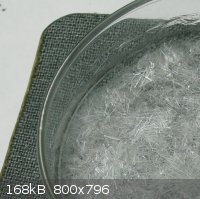learningChem
Hazard to Others
  
Posts: 182
Registered: 21-7-2011
Member Is Offline
Mood: No Mood
|
|
Vanillin - adulterated?
I bought something that's supposed to be vanillin, but I'm not sure if it's actually pure vanillin.
It doesn't smell like vanilla flavoring. It hardly has any smell at all - or else my sense of smell is defective.
It's a slightly yellow, crystalline powder. I tasted it and the flavor does resemble vanilla. It doesn't taste sweet so I suppose if it's adulterated,
the impurity isn't sugar.
I put something like 0.2 g of the powder in a test tube and covered it with water (say 1ml) and it didn't dissolve. I added a bit of NaOH solution and
the powder dissolved resulting in a yellow solution.
I also did a melting point using my homemade mp apparatus (I need to redesign it - it sucks) and the result was "around 75 c" (I know, pretty
unscientific =P)
Any comments will be appreciated!
|
|
|
Hexavalent
International Hazard
    
Posts: 1564
Registered: 29-12-2011
Location: Wales, UK
Member Is Offline
Mood: Pericyclic
|
|
Structure of vanilin, for everybody's reference;

Try recrystallizing and look for long, knife-like crystals. The lack of smell you describe indicates that little or perhaps no vanilin is present, so
thoroughly read the label on what you bought. Get someone else to smell it for a second opinion, just in case. If you tried to do a vanillin
extraction using a solvent, are you certain that you obtained was actually the product and did not keep the waste?? Please be more specific in your
question, as it will allow for more informative answers.
Pure vanillin melts at 81-83*C IIRC, so the quite low melting point seems to indicate either extreme impurities or a lack of vanillin altogether.
What did you actually buy? A lab chemical or a household product, for baking, for instance? Tell us more and we shall help you more.
This video by Myst32 could be of use.
[Edited on 2-4-2012 by Hexavalent]
"Success is going from failure to failure without loss of enthusiasm." Winston Churchill
|
|
|
peach
Bon Vivant
    
Posts: 1428
Registered: 14-11-2008
Member Is Offline
Mood: No Mood
|
|
| Quote: | | It hardly has any smell at all |
Food flavourings are usually dissolved in alcohol and water to encourage them to spread through the food evenly, rather than sitting as lumps or oily
patches of intensity. The alcohol helps more of it get airborne as well, which may be why your solid doesn't have much of a smell as is. Pure
flavourings often don't smell or taste precisely how people expect them to.
It's good you've tried to get a melting point for it, but knowing absolutely nothing about how accurate your apparatus is, it's hard to tell. You are
not all that far off the MP. The error could simply be the apparatus and a bit of error in the sample it's self.
Your best bet is to recrystallise it.
You could also test it with Tollens reagent (the silver mirror) for the aldehyde. And / or ferric chloride for the phenol (the ferric chloride will go green if it's there).
I expect it's simply that it's in a pure form and solid, messing with your senses and what they're used to in finished products. There is no
'complexity' to pure artificial flavours.
|
|
|
DJF90
International Hazard
    
Posts: 2266
Registered: 15-12-2007
Location: At the bench
Member Is Offline
Mood: No Mood
|
|
Vanillin is a pale yellow crystalline substance. It should dissolve in sodium hydroxide solution (phenoxide formation) and you should be able to
identify the phenol and the aldehyde via functional group specific stains (FeCl3 and 2,4-DNPH respectively, amongst others). The low melting point
could be due to the fact that you ramped the temperature too fast in which case your mp apparatus is suffering from poor thermal equilibrium between
the heat source and the thermometer. The heating rate should be something like 20*C/min until you're 10*C below the expected melting point, and then
1*C/min following that. You may be able to form the bisulfite adduct and obtain a melting point of that too. I'd concentrate on trying to get
something pure to calibrate your melting point apparatus - perhaps something like menthol or camphor that can be had from the chemist/pharmacy.
|
|
|
learningChem
Hazard to Others
  
Posts: 182
Registered: 21-7-2011
Member Is Offline
Mood: No Mood
|
|
Hexavalent,
Thanks for your reply!
I recrystallized it from hot water and got white needles (around 1cm long)
I didn't extract the vanillin from liquid vanilla flavoring - I bought 100g of the stuff (supposedly pure) for ~$8. I bought it from a shop that sells
technical grade reagents. They are more or less 'reputable', but that doesn't necessarily mean much here (south america)
Thanks for the video. Watching it now.

|
|
|
learningChem
Hazard to Others
  
Posts: 182
Registered: 21-7-2011
Member Is Offline
Mood: No Mood
|
|
Peach, DJF90,
Yes, the melting point is not that far off I think considering that my experimental error is probably big. I didn't ramp up the temperature in a
specially graceful way for instance =P
I'll take a look into identifying the phenol group using FeCl3, and/or the aldehyde using Tollens Reagent (now I need to procure a silver coin =P)
Thank guys!
|
|
|
DieForelle
Hazard to Self
 
Posts: 61
Registered: 2-2-2012
Location: East Coast
Member Is Offline
Mood: No Mood
|
|
Pure flavourings often don't smell or taste precisely how people expect them to.
This is true, but I can vouch for the fact that pure ethyl vanillin is quite fragrant, even as a powder. Pleasantly so. It's also completely white.
Seasonally relevant: it's the fragrance of Cadbury (US) hard shell eggs.
[Edited on 3-4-2012 by DieForelle]
[Edited on 3-4-2012 by DieForelle]
|
|
|
bfesser
|
Thread Split
11-2-2014 at 14:40 |